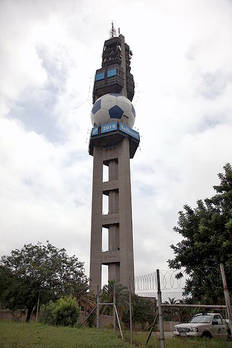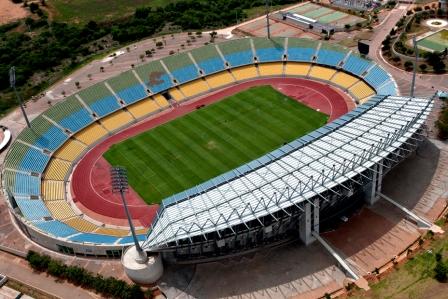World Cup Technology
Interview with
Meera - This week saw an historic moment in football, the kick-off of the First World Cup ever to be held in an African nation. I spoke to Kelvin Kemm from Pretoria in South Africa to find out what things are like over there and how science and technology is being used to make sure the games are as safe and accessible to as many people as possible in South Africa.
Kelvin - Well Meera, everybody's going World Cup mad here. On large TV masts and  the cell phone masts there's huge soccer balls on the masts there. Everybody's got soccer balls all over the place. On every placard you can imagine there are soccer pictures. All the teams are arriving day by day and every team has been met at the airport and wave down the street. Everybody is riding around with flags out of their car windows, so you can't look anywhere now that there isn't soccer fever all over the place.
the cell phone masts there's huge soccer balls on the masts there. Everybody's got soccer balls all over the place. On every placard you can imagine there are soccer pictures. All the teams are arriving day by day and every team has been met at the airport and wave down the street. Everybody is riding around with flags out of their car windows, so you can't look anywhere now that there isn't soccer fever all over the place.
Meera - And have there been any particular science or technological developments in relation to the World Cup, say to help people watch it or even for security reasons?
Kelvin - There's been some interesting things. For example, one company has taken a number of solar powered television sets into far remote areas that are not electrified, so all our local villagers can to come along and sit and watch the World Cup on TV. Also, something else interesting is about the security as you mentioned. There's huge security coverage. For example, if a model airplane takes off, a radio controlled plane, and aims towards the stadium, the military and security command centre can detect that model airplane and crash it - if it goes on a path towards our soccer stadium. By radio jamming, they will jam the radio signals so the aircraft crashes.
And even base jumpers - every base jumper has got to be registered and can't jump within a certain radius of a stadium unless they get permission, which they won't get during a game.
 But large and small aircraft as well, every single aircraft from a small private airplane to the Boeing 747s has got to ask permission to cross a 100 kilometre radius around the game, every single time they cross, and we're talking about thousands of occasions. Each one has to be individually certified, and the planes all have to register beforehand so they know exactly who owns the aircraft and what it's doing. So any strange aircraft will be stopped.
But large and small aircraft as well, every single aircraft from a small private airplane to the Boeing 747s has got to ask permission to cross a 100 kilometre radius around the game, every single time they cross, and we're talking about thousands of occasions. Each one has to be individually certified, and the planes all have to register beforehand so they know exactly who owns the aircraft and what it's doing. So any strange aircraft will be stopped.
Something else too which the world can look forward to is the massive television coverage there is going to be - each stadium has got something like 32 cameras per game operated through a giant television coverage centre that has been specifically put aside for the soccer only. So it'll run 24 hours a day just sending TV all over the world. It'll be the largest international television traffic that's ever been sent out of South Africa is the coverage of the soccer.









Comments
Add a comment